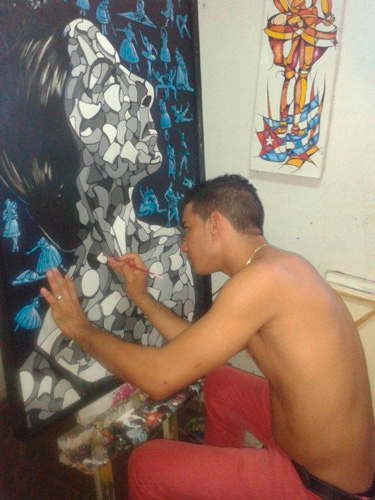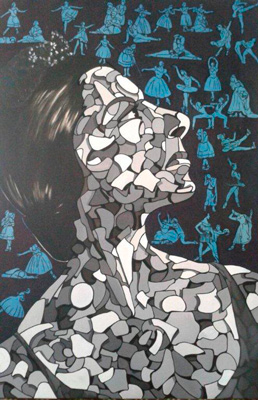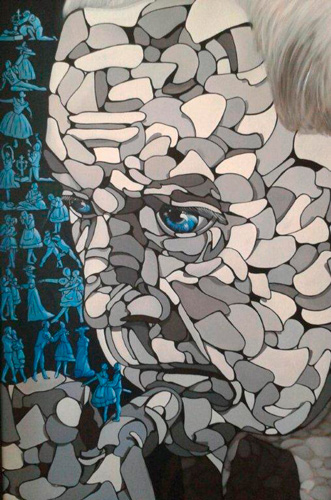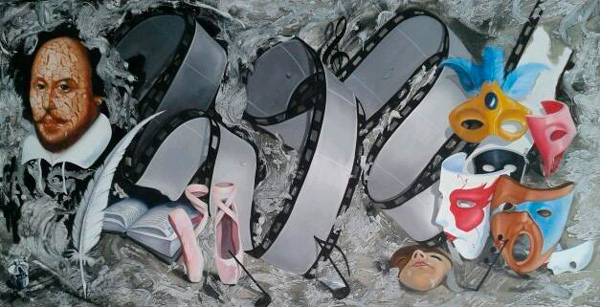The Ballet Paintings of Cuban Artist Miguel Quintana
By Helson Hernandez

HAVANA TIMES — Young Cuban painter Miguel Angel Quintana Amador has found the visual elements for his works in the legacy of prima ballerina Alicia Alonso and ballet, understood as a world of expression. “I don’t cling to new tendencies, I paint on impulse.”
HT: What is background?
Miguel Ángel: I am a self-taught painter. I’ve liked the visual arts since I was little. I would draw anything that made an impression on me and, as early as age 9, I would participate in drawing competitions, where I received a number of awards and even a first prize. I started sculpting in plasticine, soap and wood at the time. Later, I took on stone sculpting and managed to produce some quality pieces.
That is how I started. Without putting drawing aside, I began experimenting with engraving and developed my own style – I even taught a class on the subject. Then, I started doing naïve art, recreating everyday scenes, arriving at a very personal style which I’ve maintained and that has a great deal of appeal in Cuba and abroad. My first important pictorial work was based on a painting by Boris Vallejos. I titled it Angel. This work was an incentive to continue painting and to follow my own inspiration.
HT: What is the significance of dance in your work?

MA: Classical dance is my biggest source of inspiration, and I came upon it by accident. I began painting landscapes, marinas, still lives, cornucopias and portraits. I like painting the human body very much. I also enjoy painting urban scenes and buildings, streets. Dance has much significance for me as my interest in the body. When I attended my first and unforgettable performance of Giselle, the first thing that struck me was seeing Alicia Alonso up close, very close to me, on stage, receiving a standing ovation from the public, myself included.
That got to me and captivated me. At home, they would show me videos and we would watch ballet programs. Thanks to these, I already knew Alicia Alonso, the star she was and what her legacy represented, but seeing her up close awakened an interest in me and I decided to paint her and give her my humble work as gift. When the ballet started, I came into contact with a new form of bodily expression, of a kind I never imagined, bodily gestures that said it all – and I headed home to paint.
A short time later, I was standing in front of Alicia, handing her my first ballet piece. That is how my exhibition at Havana’s 2012 International Ballet Festival took shape. It was my third exhibition and my first with pieces dealing exclusively with the world of ballet.
HT: What techniques and styles do you use in your paintings?

MA: I like painting without any academic constraints. When I get inspired, I think of the way in which I can express what I want. I prefer classical, neo-classical, naturalist, romantic and impressionistic currents, but I drift towards abstraction and the figurative through the Trencadis mosaic technique, the ancient form of representation of the Byzantines. Their works are like jig-saw puzzles assembled from brightly-colored or matte ceramic pieces of an incredible beauty, like stained-glass pieces.
I assemble the jig-saw puzzle backwards. I start to create shapes joining cells within a given outline, until I have created the desired figure and given it expression. It’s hard work, but I feel great satisfaction at the end – which is why I have no plans of abandoning this style.
HT: Is it challenging to be an artist today?
MA: I believe it is. It is challenging to paint these days, when there are many excellent young artists who, like me, show us their way of expressing things, all of them valuable. For me, the most important thing is believing in oneself, developing one’s style. An artist will always have admirers and detractors. I don’t cling to new tendencies. I paint on impulse and, if I want to reproduce something the way I see it in reality, I do not hesitate to do so. The end result will always be a painting, it will be creative, I will never see it as a photograph, it will have the seal of something living, of interpretation, it won’t be like a machine reproduction, which is based on a different technique and, of course, a different form of interpretation. Everything in life consists in learning from those who have come and done before.
I’ll give you an example from the world of dance. Today we continue to enjoy such classics as Swan Lake, Sleeping Beauty, The Nutcracker, Giselle and other works that are restaged with more or less adaptations, but without any substantial changes, and we will continue to enjoy these in the future. We simply enjoy the way in which each dancer feels the performance individually. Even though there are very innovative choreographies out there, the staging of the classics are the most celebrated, even though people are able to appreciate innovation. That is how I regard painting.

HT: Tell us about El Arte se Nutre del Arte (“Art Draws From Art”)
MA: It’s one of the exhibitions that has been most moving for me. To be able to pay tribute to William Shakespeare, Alicia Alonso, the maestro of maestros Fernando Alonso, Ramona de Saa and all the dancers that reach us with their art, using some of the most renowned works by Shakespeare as an inspiration for my paintings, being able to participate this way in Havana’s 24th International Ballet Festival, is more than enough to bell honored and satisfied.
HT: What are your future projects?
MA: I am waiting for the launch of a book about Carmen and Alicia Alonso, and a multimedia that includes a number of my works. I am also involved in the preparation of works that will be exhibited at the 21st International Gathering of Ballet Academies held every year at Havana’s National Ballet School, where I have a permanent exhibit of some works from the previous event.
We are working with the director of the institution, ballet instructor Ramona de Saa, to create a permanent workshop and exhibition space at the National Ballet School that can serve as a vocational workshop. This is another project for children with an inclination for the arts that I will be working on very soon in Guanabo, which is where I currently live.





